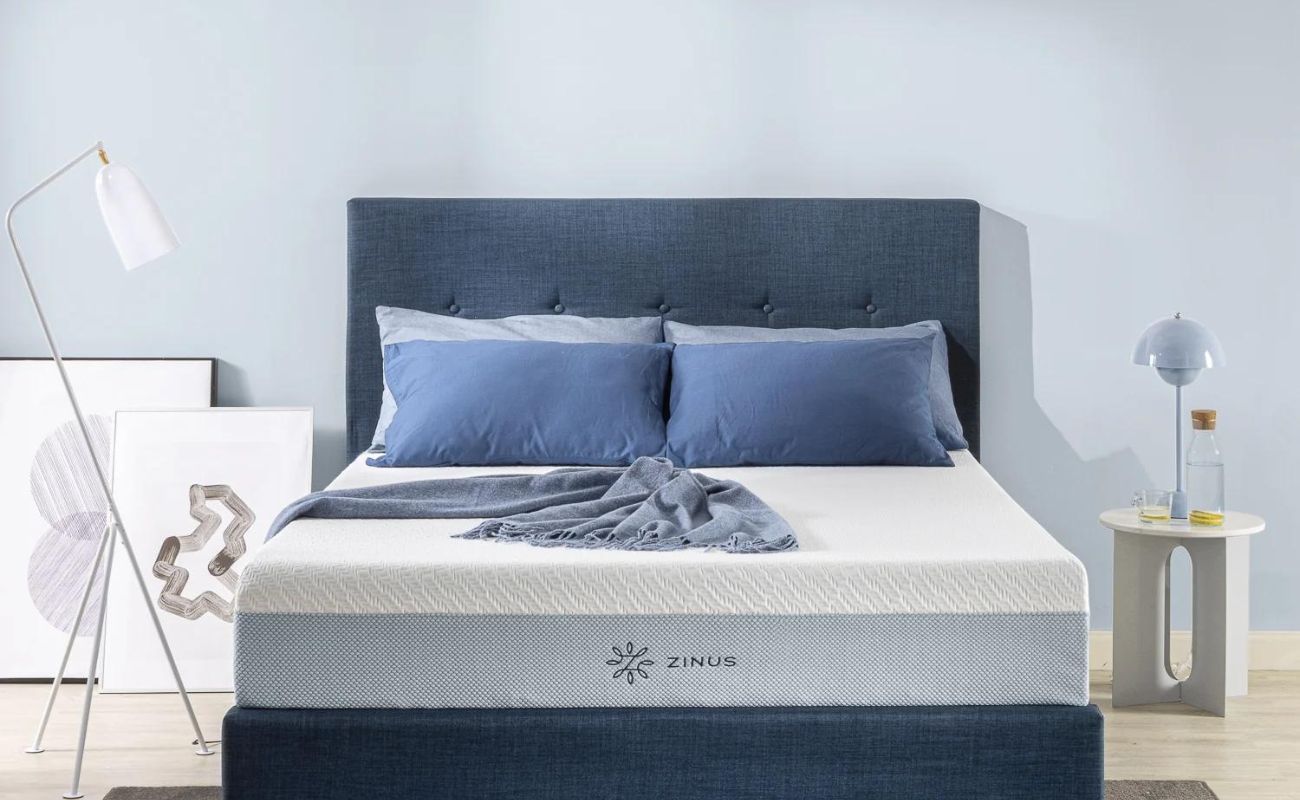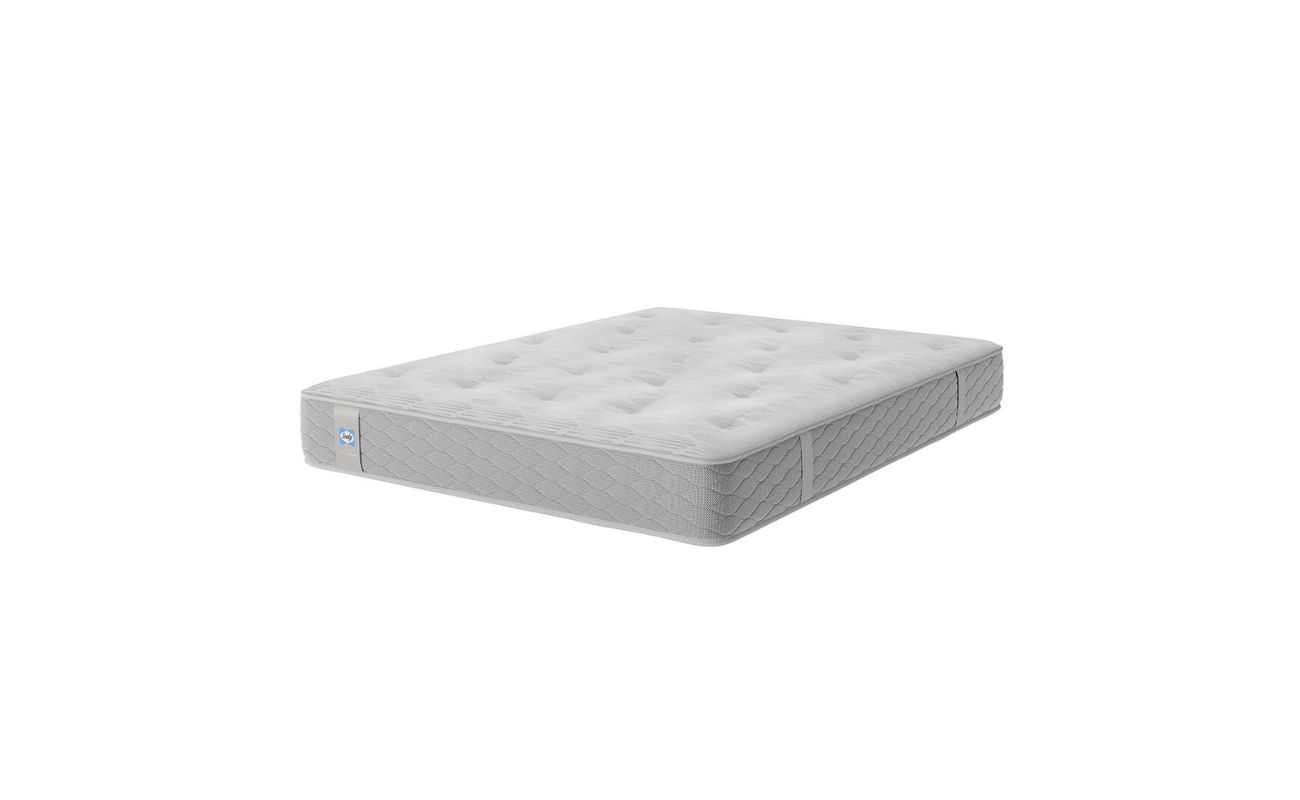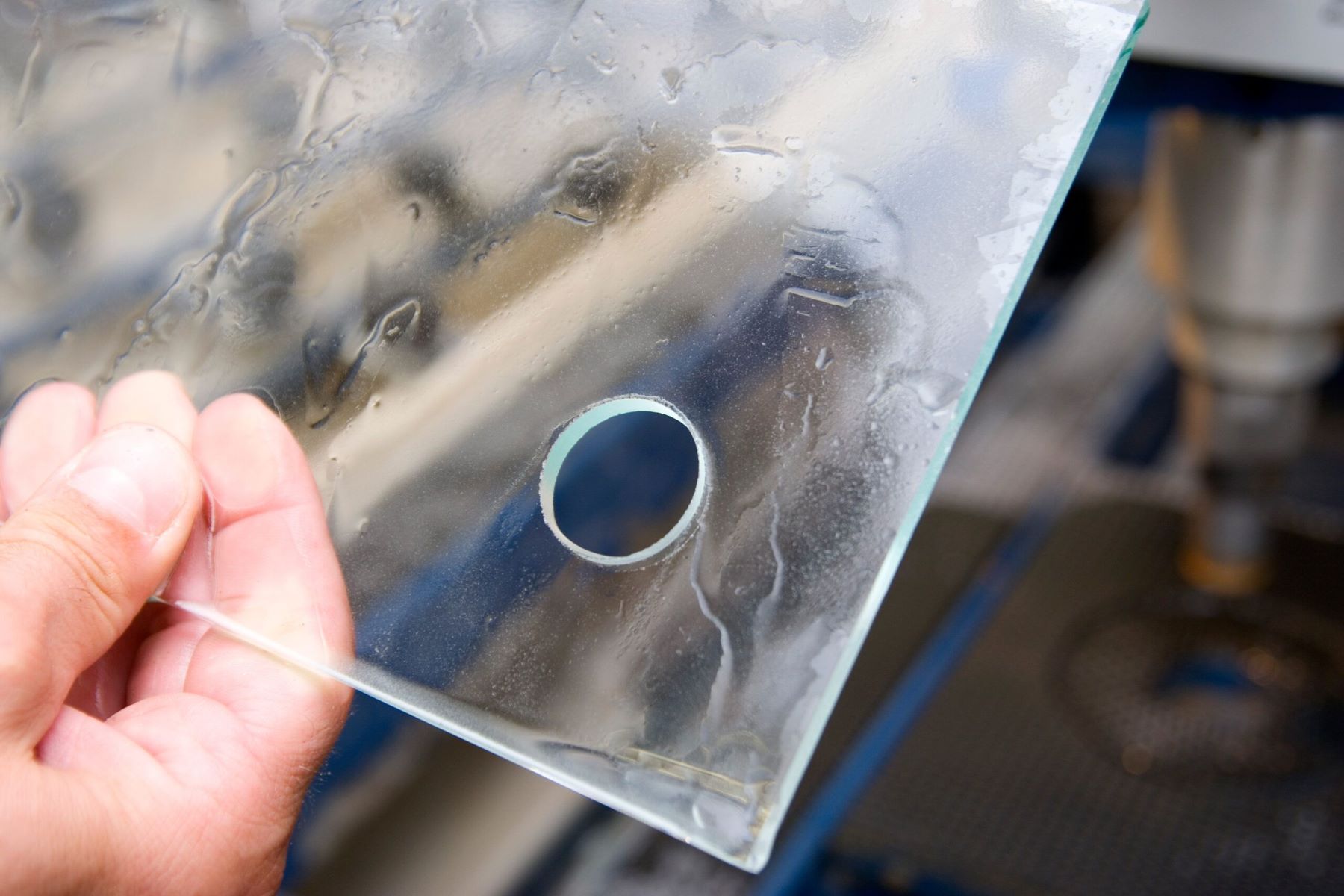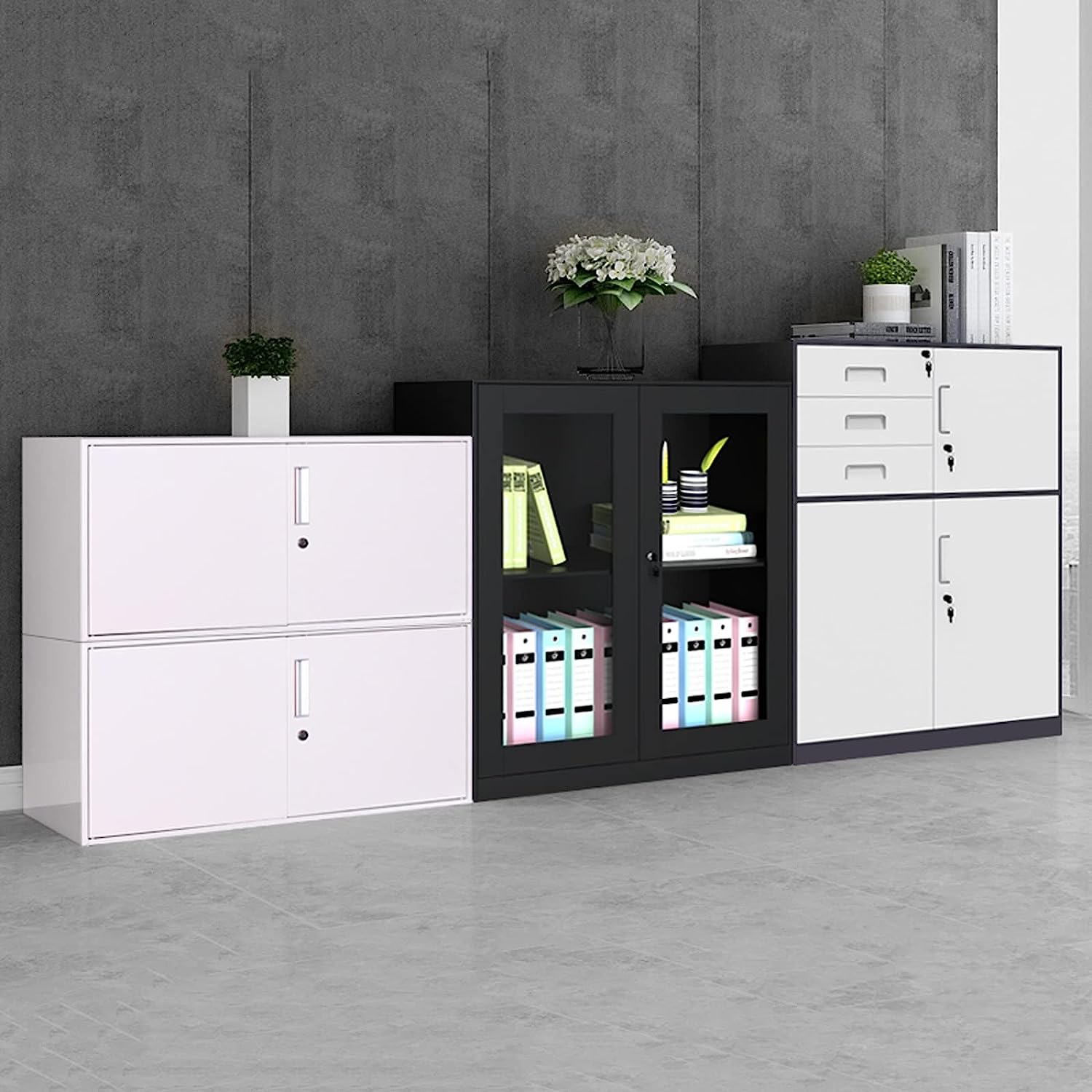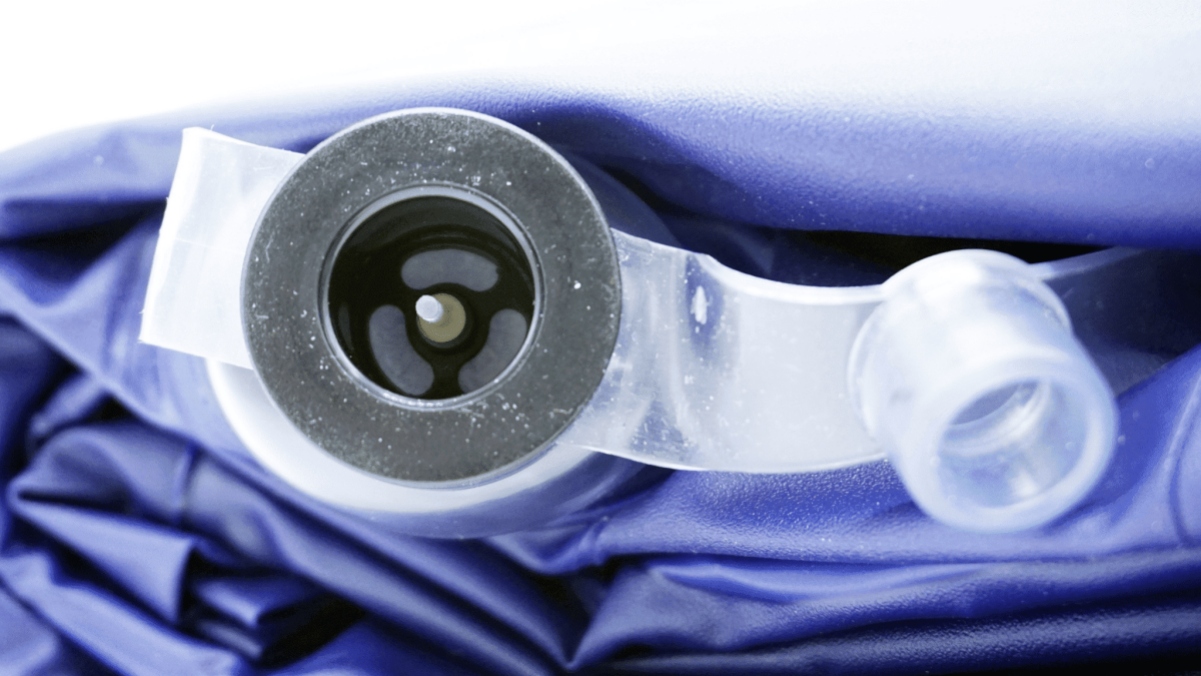Home>Furniture>Bedroom Furniture>How Long For A Mattress To Break In


Bedroom Furniture
How Long For A Mattress To Break In
Modified: August 17, 2024
Discover how long it takes for a mattress to break in and become truly comfortable. Enhance your bedroom furniture with our expert advice and tips.
(Many of the links in this article redirect to a specific reviewed product. Your purchase of these products through affiliate links helps to generate commission for Storables.com, at no extra cost. Learn more)
Introduction
When you invest in a new mattress, you want it to provide you with the utmost comfort and support for a good night’s sleep. However, many people may find that their new mattress feels a bit different from what they expected initially. This is because mattresses, just like any other product, require some time to “break in” and reach their optimal level of comfort.
In this article, we will explore the concept of mattress break-in and discuss the factors that can affect how long it takes for a mattress to reach its full potential. Whether you have recently purchased a foam, innerspring, hybrid, or latex mattress, understanding the break-in process can help you set realistic expectations and maximize your sleep quality. We will also provide tips to expedite the break-in period, so you can start experiencing the full benefits of your new mattress sooner.
Before diving into the specifics, it’s important to note that mattress break-in time can vary for different individuals. Factors such as material composition, personal preferences, sleep trial periods, and more can all influence how long it takes for a mattress to fully break in. Therefore, it’s essential to be patient and give your mattress the time it needs to adjust to your unique body and sleeping habits.
Now, let’s explore each factor that can contribute to the break-in time of different mattress types.
Key Takeaways:
- Understanding the break-in process of your new mattress is essential for realistic expectations. Factors like material composition, personal preferences, and sleep habits can influence the adjustment period. Patience and following manufacturer’s recommendations are key to maximizing comfort.
- To expedite the break-in time, consider rotating the mattress, consistent use, and allowing for proper ventilation. Utilize the sleep trial period to assess comfort and support, and communicate with the manufacturer for guidance. Remember, each mattress is unique, so be patient and allow it to conform to your body for the best sleep experience.
Read more: How Long To Break In A Mattress
Factors Affecting Mattress Break-in Time
The break-in time of a mattress can be influenced by various factors. Understanding these factors can help you set realistic expectations and avoid any potential disappointment during the initial stages of using your new mattress. Let’s explore some of the key factors below:
Material Composition
The material composition of a mattress plays a significant role in how long it takes to break in. Different materials have different properties, densities, and responsiveness, which can affect the overall comfort and feel of the mattress. For example:
- Foam Mattresses: Foam mattresses, such as memory foam or polyfoam, often have a break-in period ranging from a few days to a few weeks. The foam needs time to contour and adjust to your body’s shape and temperature, providing optimal support and pressure relief.
- Innerspring Mattresses: Innerspring mattresses typically have minimal break-in time. The coil springs immediately provide support, while the comfort layers may take a little time to adjust to your body.
- Hybrid Mattresses: Hybrid mattresses, which combine foam and innerspring components, may have a slightly longer break-in period compared to innerspring mattresses. The foam layers need time to conform to your body, while the coils provide support.
- Latex Mattresses: Latex mattresses are known for their durability and responsiveness. They often have a shorter break-in period compared to foam mattresses, as the latex quickly conforms to your body’s contours.
It’s important to note that these time frames are general guidelines, and individual experiences may vary based on mattress brands, specific materials used, and personal preferences.
Material Composition
The material composition of a mattress plays a crucial role in determining its overall comfort, support, and durability. Different materials have unique properties that can influence the break-in period and the overall feel of the mattress. Let’s take a closer look at the break-in process for various mattress types:
Foam Mattresses
Foam mattresses, such as memory foam and polyfoam, have gained popularity due to their ability to contour to the body, relieving pressure points and promoting better alignment. However, foam mattresses often come with a break-in period that can range from a few days to a few weeks.
During the initial days of using a foam mattress, you may notice a slightly firmer feel. This is because the foam needs time to adjust to your body’s unique shape and temperature. With regular use and body heat, the foam cells will soften, allowing the mattress to conform to your body more effectively. As a result, you’ll experience the true comfort and support that foam mattresses are known for.
Read more: How To Break In A Mattress
Innerspring Mattresses
Innerspring mattresses are constructed with coil springs that provide support and durability. These mattresses typically have a minimal break-in period, with the springs instantly providing a comfortable sleeping surface. However, the comfort layers, often made of foam or cushioning materials, may take a little time to adjust to your body’s contours.
During the break-in period of an innerspring mattress, the comfort layers will start conforming to your body, allowing for better pressure relief and overall comfort. This adjustment period is typically shorter compared to foam mattresses, and you should notice a more tailored feel after a short period of use.
Hybrid Mattresses
Hybrid mattresses combine the benefits of both foam and innerspring mattresses. These mattresses usually consist of a layer of coils for support and comfort layers made of foam or other materials for added pressure relief. The break-in period for hybrid mattresses is generally longer compared to innerspring mattresses.
Similar to foam mattresses, the comfort layers in a hybrid mattress will take some time to conform to your body’s shape and provide optimal support. The coil springs, on the other hand, offer instant support. With regular use, the hybrid mattress will reach its full potential, offering a balanced combination of comfort and support.
Latex Mattresses
Latex mattresses are known for their exceptional durability, breathability, and responsiveness. Unlike foam mattresses, latex mattresses often have a shorter break-in period.
Latex quickly conforms to your body’s contours, providing excellent pressure relief and support from the moment you start using the mattress. With regular use, the latex will further adapt to your body, enhancing the overall comfort and conforming properties of the mattress. If you prefer a mattress with minimal break-in time, a latex mattress might be the right choice for you.
Ultimately, the break-in time of a mattress can vary depending on the specific brand, construction, and materials used. It’s essential to follow the manufacturer’s guidelines and allow sufficient time for the mattress to adjust to your body for optimal comfort and support.
Foam Mattresses
Foam mattresses, such as memory foam and polyfoam, have gained popularity in recent years due to their ability to provide exceptional comfort and support. These mattresses are known for their contouring properties, which help alleviate pressure points and promote better spinal alignment. However, it’s important to note that foam mattresses may have a break-in period before reaching their full potential.
During the initial days or weeks of using a foam mattress, you may notice that it feels slightly firmer than expected. This is because the foam material needs time to adjust to your body’s unique shape and temperature. Foam has a cellular structure that responds to heat and pressure, allowing it to contour to your body over time.
As you sleep on a foam mattress, your body heat softens the foam cells, causing it to conform and mold to your body’s contours. This process, known as “cradle effect,” helps distribute your weight evenly, alleviating pressure points and promoting a more comfortable sleep experience.
It’s important to note that the break-in period for foam mattresses can vary depending on factors such as the foam density, thickness, and quality of materials used. Higher-density foams may take longer to break in compared to lower-density ones. Additionally, foam mattresses with advanced technologies, such as gel-infused or open-cell foams, may have shorter break-in periods due to their enhanced breathability and responsiveness.
During the break-in period, it’s common to experience a slight odor known as off-gassing. This is a normal occurrence in foam mattresses and is caused by the release of volatile organic compounds (VOCs) that are trapped within the foam. The odor should dissipate within a few days to a few weeks, especially with proper ventilation and allowing the mattress to breathe. You can also expedite the process by airing out the mattress in a well-ventilated room before use.
To accelerate the break-in process of a foam mattress, you can follow a few tips:
- Rotate the mattress regularly: This helps distribute body weight and wear evenly, allowing the foam to adjust more quickly.
- Use the mattress regularly: Regular use promotes the softening and contouring of the foam, speeding up the break-in period.
- Avoid placing heavy objects on the mattress: Excessive weight can compress the foam, resulting in uneven wear. This may hinder the break-in process.
- Be patient: It’s important to give your foam mattress enough time to adjust to your body. While some people may experience the full benefits within a few days, others may require a few weeks of consistent use.
By following these tips and allowing your foam mattress to naturally adapt to your body, you can ensure that you enjoy the maximum comfort and support it has to offer. Remember, each foam mattress is unique, and the break-in period can vary, so it’s essential to be patient and allow the mattress to reach its full potential.
Read more: How To Break In A Memory Foam Mattress
Innerspring Mattresses
Innerspring mattresses have long been a popular choice for individuals seeking firm support and a traditional mattress feel. These mattresses are constructed with a system of coil springs that provide the necessary support for a restful night’s sleep. Innerspring mattresses typically have minimal break-in time compared to other mattress types.
When you first sleep on an innerspring mattress, you should notice the immediate support provided by the coil springs. These springs are designed to distribute weight evenly and maintain proper spinal alignment while you sleep. However, it’s important to note that the comfort layers, often made of foam or cushioning materials, may take a little time to adjust to your body’s contours.
During the break-in period of an innerspring mattress, the comfort layers will begin to conform to your body, providing enhanced pressure relief and overall comfort. This adjustment period is typically shorter compared to foam mattresses, as the coil system offers instant support. With regular use, you should notice that the mattress becomes more tailored to your body’s shape and preferences.
It’s important to keep in mind that the break-in period of an innerspring mattress can vary depending on factors such as the coil gauge, coil count, and the quality of the comfort layers. Higher-quality materials may adjust more quickly, while lower-quality materials may require a bit more time.
To expedite the break-in process of an innerspring mattress, you can follow a few tips:
- Rotate the mattress regularly: Rotating the mattress every few months helps distribute weight and wear evenly, allowing the comfort layers to adjust more effectively.
- Allow for proper ventilation: Innerspring mattresses benefit from good airflow to prevent heat buildup and maintain freshness. Proper ventilation can help speed up the break-in process.
- Give it time: While innerspring mattresses typically have a shorter break-in period compared to foam mattresses, it’s important to be patient. Allow the mattress a few weeks to a month of consistent use for the comfort layers to fully adjust and provide optimal comfort.
By following these tips and giving your innerspring mattress time to conform to your body, you can ensure that you experience the full benefits of its support and comfort. Remember, the break-in period may vary slightly depending on the specific brand and construction of the mattress, so it’s important to set realistic expectations and allow the mattress to adapt to your body over time.
Hybrid Mattresses
Hybrid mattresses have gained popularity among individuals looking for a balance between the support of innerspring mattresses and the comfort of foam or other cushioning materials. These mattresses typically consist of a combination of pocketed coil springs and comfort layers made of foam, latex, or other materials. The break-in period for hybrid mattresses can range from minimal to slightly longer compared to innerspring mattresses.
When you first sleep on a hybrid mattress, you’ll experience the instant support provided by the coil springs. The coil system helps distribute weight evenly and promotes proper spinal alignment. However, the comfort layers, which are designed to offer pressure relief and contouring, may take some time to adjust to your body’s unique shape.
During the break-in period of a hybrid mattress, the foam, latex, or other comfort materials will gradually conform to your body, providing enhanced support and comfort. The combination of the coil system and the comfort layers allows for a responsive and tailored sleep surface. With regular use, you’ll notice a more personalized feel as the mattress adjusts to your body’s contours.
The break-in time of a hybrid mattress can vary depending on the specific brand, quality of materials used, and individual preferences. Higher-quality materials and advanced construction techniques may result in a shorter break-in period, while lower-quality materials may require additional time to fully adjust.
To expedite the break-in process of a hybrid mattress, consider the following tips:
- Rotate the mattress regularly: Rotating the mattress every few months helps promote even wear and allows the comfort layers to adjust more effectively.
- Use the mattress consistently: Regular use helps soften the comfort layers and allows the mattress to conform to your body faster.
- Allow for proper airflow: Hybrid mattresses benefit from good airflow to maintain freshness and prevent heat buildup. Proper ventilation can help speed up the break-in process.
- Be patient: While hybrid mattresses typically have a shorter break-in period compared to foam mattresses, it’s important to give the mattress time to adjust to your body. Allow a few weeks to a month for the comfort layers to fully conform and provide optimal support and comfort.
By following these tips and allowing your hybrid mattress to naturally adapt to your body, you can ensure that you enjoy the optimal blend of support and comfort it offers. Remember that each mattress is unique, and the break-in period may vary slightly, so it’s important to be patient and allow the mattress to reach its full potential for a restful night’s sleep.
Latex Mattresses
Latex mattresses are known for their exceptional durability, breathability, and responsiveness. These mattresses are made from natural or synthetic latex, which is derived from the sap of rubber trees. Latex mattresses often have a shorter break-in period compared to other mattress types.
When you first sleep on a latex mattress, you’ll immediately experience its supportive and responsive nature. Latex quickly conforms to your body’s contours, offering excellent pressure relief and support. The natural elasticity of latex allows it to bounce back to its original shape when you change positions, ensuring a consistent level of comfort throughout the night.
Unlike foam mattresses, latex mattresses typically have minimal initial firmness. This means that they don’t require an extensive break-in period to reach their optimal level of comfort. However, with regular use, the latex will further adjust to your body’s shape and preferences, enhancing the overall comfort and conforming properties of the mattress.
It’s important to note that the break-in period of a latex mattress can vary depending on factors such as the quality of latex used, the thickness of the comfort layers, and the individual’s preferences. Higher-quality latex, such as natural latex, may have a shorter break-in period compared to synthetic latex.
To expedite the break-in process of a latex mattress, consider the following tips:
- Rotate the mattress regularly: Rotating the mattress every few months helps promote even wear and prevents the formation of permanent impressions.
- Allow for proper ventilation: Proper airflow is essential to maintain the freshness of the latex mattress and prevent heat buildup. Good ventilation can also help speed up the break-in process.
- Use the mattress consistently: Regular use helps the latex conform to your body more quickly and ensures that you experience the full benefits of its supportive and pressure-relieving properties.
- Be patient: While latex mattresses generally have a shorter break-in period, it’s important to give the mattress a few weeks to fully adjust to your body for optimal comfort and support.
By following these tips and giving your latex mattress the time it needs to adapt to your body, you can ensure that you enjoy the maximum benefits it has to offer. Remember, each mattress is unique, and individual preferences may vary, so it’s important to set realistic expectations and allow the mattress to reach its full potential for a comfortable and restful sleep.
Pillows and Toppers
When it comes to achieving the ultimate sleep experience, pillows and mattress toppers play a vital role. While they are not mattresses themselves, they can greatly impact the overall comfort and support of your sleep surface. It’s important to note that pillows and toppers may also have a break-in period as they conform to your body and adjust to your preferences.
Pillows
Pillows are essential for maintaining proper spinal alignment and supporting your head and neck during sleep. They come in various materials and designs, including memory foam, latex, down, and polyester fibers. Pillows made of memory foam or latex may require a short break-in period to adjust and conform to your head and neck shape.
When you first start using a new pillow, it may feel a bit firmer or less flexible. However, with regular use, your body heat and pressure will soften the pillow’s materials, allowing them to contour to your specific shape and provide optimal support. It’s important to note that this break-in process may vary depending on the pillow’s material composition and your personal preferences.
During the break-in period, it’s common to experience the pillow’s fill settling or shifting. This can be easily remedied by fluffing the pillow regularly to restore its shape and loft. Some pillows may also have a slight odor upon initial use, which is typically harmless and will dissipate over time.
Mattress Toppers
Mattress toppers are additional layers of cushioning that you can place on top of your mattress to enhance its comfort and support. They are often made of memory foam, latex, down, or other materials. Mattress toppers can provide extra pressure relief, temperature regulation, and even adjust the firmness level of your mattress.
Similar to pillows, mattress toppers may have a break-in period as they adjust and conform to your body’s shape. Memory foam and latex toppers may take a few days to a few weeks to fully adjust and provide the desired level of comfort. During this time, the topper will soften and align with your body, allowing for a more customized sleep experience.
It’s important to note that the break-in period of pillows and toppers can vary depending on factors such as material quality, density, and individual preferences. Following the manufacturer’s guidelines and allowing sufficient time for the materials to adjust is important to experience the full benefits of pillows and toppers.
To expedite the break-in process of pillows and toppers, consider the following tips:
- Air them out: Allow new pillows and toppers to air out in a well-ventilated area to remove any potential odors or off-gassing.
- Fluff and rotate: Regularly fluffing pillows and rotating mattress toppers can help them adjust more evenly and quickly.
- Use and adjust: Consistent use of pillows and toppers will help them conform to your body faster. Adjust the height, loft, or position to ensure optimal support and comfort.
By following these tips and giving your pillows and toppers adequate time to adjust, you can ensure that you enjoy the maximum comfort and support they are designed to provide. Remember, the break-in period may vary depending on the specific materials used and individual preferences, so it’s important to be patient and allow them to adapt to your needs over time.
Personal Factors
When it comes to the break-in time of a mattress, it’s important to consider personal factors that can influence the experience. Here are a few key factors to keep in mind:
Body Weight and Size
Your body weight and size can affect how quickly a mattress breaks in and adjusts to your body. Heavier individuals may find that it takes a little longer for the mattress to fully conform to their body contours, while lighter individuals may experience a faster break-in period. Additionally, the distribution of your weight and pressure points can impact how the mattress adapts to your body over time.
Read more: How Long Are Mattress Warranties
Sleeping Position
Your preferred sleeping position can also impact the break-in time of a mattress. Different sleeping positions exert different amounts of pressure on certain areas of the body. For example, side sleepers may require more time for the mattress to contour to their hips and shoulders, while back or stomach sleepers may experience a quicker break-in period in those areas.
Sleeping Habits
Your sleeping habits can play a role in the break-in time of a mattress as well. The amount of time you spend in bed, the frequency of movement during sleep, and other factors can impact how quickly the mattress adjusts to your body. Regular use and consistent sleeping habits can help expedite the break-in process.
Preferences and Sensitivities
Personal preferences and sensitivities can also influence how quickly a mattress breaks in. Some individuals may have a higher sensitivity to the materials used in the mattress, which may affect how quickly they adjust to it. Similarly, preferences for a firmer or softer feel can influence the perception of the break-in time. It’s important to choose a mattress that aligns with your preferences and allows for a comfortable sleep experience.
Environmental Factors
Environmental factors, such as temperature and humidity, can impact the break-in time of a mattress. In warmer climates, the mattress materials may soften more quickly, while in colder environments, it may take a little longer for the materials to adjust. Additionally, high humidity levels can affect the breathability and responsiveness of the mattress.
It’s important to keep in mind that personal factors can vary from individual to individual. The break-in time of a mattress may be influenced by a combination of these factors, ultimately affecting the overall comfort and feel of the mattress for each person.
By taking into account these personal factors, you can better understand and manage your expectations regarding the break-in time of your mattress. Remember, it’s essential to allow sufficient time for the mattress to adapt to your body and preferences, ensuring a comfortable and supportive sleep surface.
Read more: How Long Is A Baby Mattress Good For
Sleep Trial Periods
Many mattress manufacturers offer sleep trial periods, allowing customers to try out their new mattress in the comfort of their own homes. Sleep trial periods typically range from 30 to 120 nights, giving you an extended period to test the mattress and ensure it’s the right fit for you. Sleep trials can be beneficial when it comes to determining the break-in time and overall comfort of a mattress.
During a sleep trial, you have the opportunity to assess how the mattress feels and performs over an extended period. This allows you to experience the full spectrum of the break-in process and determine whether the mattress meets your comfort and support needs.
Here are a few key points to consider when it comes to sleep trial periods:
Break-in Time within the Sleep Trial Period
It’s important to note that the break-in time of a mattress can occur within the sleep trial period. While some mattresses may feel comfortable from the first night, others may require a longer adjustment period. By taking advantage of the sleep trial, you can assess whether the mattress’s comfort level improves as it breaks in, and determine if it meets your expectations over time.
Comfort Level and Support
During the sleep trial, pay close attention to the comfort level and support provided by the mattress. Take note of how well it conforms to your body, alleviates pressure points, and supports your spine. If you find that the mattress doesn’t meet your expectations in terms of comfort and support during the sleep trial, you may have the option to return or exchange it for a different model or brand.
Return and Exchange Policies
Before purchasing a mattress with a sleep trial period, familiarize yourself with the return and exchange policies. Understand the terms and conditions, including any fees or requirements for returning or exchanging the mattress. It’s important to ensure that you’re comfortable with these policies before committing to a specific mattress.
Read more: How Long Is A Twin XL Mattress
Communication with the Manufacturer
If you have any concerns or questions about the break-in time or overall comfort of the mattress during the sleep trial, it’s essential to communicate with the mattress manufacturer. They can provide guidance and address any issues or uncertainties you may have. They may also provide suggestions on how to expedite the break-in process or offer alternative solutions to improve your sleep experience.
Utilizing the sleep trial period can provide peace of mind and assurance when purchasing a new mattress. It allows you to fully assess the comfort, support, and break-in time of the mattress in the comfort of your own home, ensuring that you make an informed decision and select the right mattress for your needs.
Remember to read and understand the terms and conditions of the sleep trial, including any specific requirements or limitations, to make the most of your trial period. By taking advantage of the sleep trial, you can ensure that your investment in a new mattress is one that promotes restful and rejuvenating sleep.
Tips for Expediting Mattress Break-in
While mattresses naturally go through a break-in period, there are a few tips you can follow to help expedite the process and start experiencing optimal comfort and support sooner. Here are some useful tips to speed up the break-in time of your mattress:
Rotate the Mattress
Regularly rotating your mattress can help promote even wear and distribute your body weight more evenly. By rotating the mattress every few months, you encourage the materials to adjust and conform to your body more quickly. This can help expedite the break-in process and allow for a more personalized sleep experience.
Sleep on It Consistently
Using the mattress consistently can help expedite the break-in time. Aim to sleep on your new mattress every night to allow your body weight and heat to naturally soften the materials. The more you use the mattress, the faster it will adjust to your body and sleeping habits.
Read more: How Long Is A Short Queen Mattress
Give It Time
While it can be tempting to expect instant comfort from a new mattress, it’s important to be patient and give it enough time to break in. Most mattresses require a few weeks to fully adjust to your body and reach their optimal level of comfort and support. Allow the mattress to naturally adapt to your body’s contours over time.
Remove the Packaging and Air It Out
When you first receive your new mattress, be sure to remove any packaging and allow it to air out in a well-ventilated room. This can help eliminate any odors associated with the manufacturing or shipping process. Airing out the mattress can also help expedite the break-in process by allowing the materials to breathe and adjust more effectively.
Use a Mattress Topper
If you want to enhance the comfort and soften the feel of your mattress during the break-in period, consider using a mattress topper. A topper made of memory foam, latex, or other cushioning materials can provide an extra layer of plushness and help expedite the break-in time by conforming to your body more quickly.
Follow Manufacturer’s Recommendations
Always follow the manufacturer’s recommendations and guidelines for your specific mattress. They may provide information and suggestions on how to expedite the break-in process based on the materials and construction of the mattress. It’s important to adhere to these recommendations to ensure the best possible results.
By following these tips, you can help expedite the break-in time of your new mattress and start enjoying the optimal comfort and support it provides. Remember, each mattress is unique, and the break-in period may vary, so it’s essential to have patience and allow the mattress to conform to your body’s contours for the best sleep experience.
Read more: How Long To Expand A Tulo Mattress
Conclusion
Understanding the break-in process of a mattress is crucial for setting realistic expectations and maximizing your sleep comfort. Whether you have a foam, innerspring, hybrid, or latex mattress, each type requires a certain amount of time to fully adjust and conform to your body. While the break-in period can vary depending on factors such as material composition, personal preferences, and sleeping habits, there are steps you can take to expedite the process and start enjoying the full benefits of your mattress sooner.
By rotating your mattress regularly, sleeping on it consistently, and giving it ample time, you allow the materials to adjust and conform to your body more effectively. Additionally, removing the packaging, airing out the mattress, and using a mattress topper can also help speed up the break-in time and enhance your sleeping experience.
It’s important to consider personal factors such as body weight and size, sleeping position, and preferences when it comes to the break-in process. These factors can influence how quickly the mattress adjusts to your body and provides optimal support and comfort. However, it’s crucial to be patient, as the break-in time may vary for each individual.
If your mattress comes with a sleep trial period, take advantage of it to assess the comfort and support of your mattress over time. This allows you to experience the full range of the break-in process and determine if the mattress meets your expectations. Communicate with the manufacturer if you have any concerns or questions during the sleep trial period, as they can provide guidance and support.
In conclusion, investing in a new mattress is an important decision to ensure a good night’s sleep. Understanding the break-in process and following the tips provided can help expedite the adjustment period and allow you to experience the full benefits of your mattress sooner. Remember to be patient, follow the manufacturer’s recommendations, and give your mattress the time it needs to conform to your body. With proper care and attention, your mattress can provide you with years of comfortable and restorative sleep.
Frequently Asked Questions about How Long For A Mattress To Break In
Was this page helpful?
At Storables.com, we guarantee accurate and reliable information. Our content, validated by Expert Board Contributors, is crafted following stringent Editorial Policies. We're committed to providing you with well-researched, expert-backed insights for all your informational needs.
